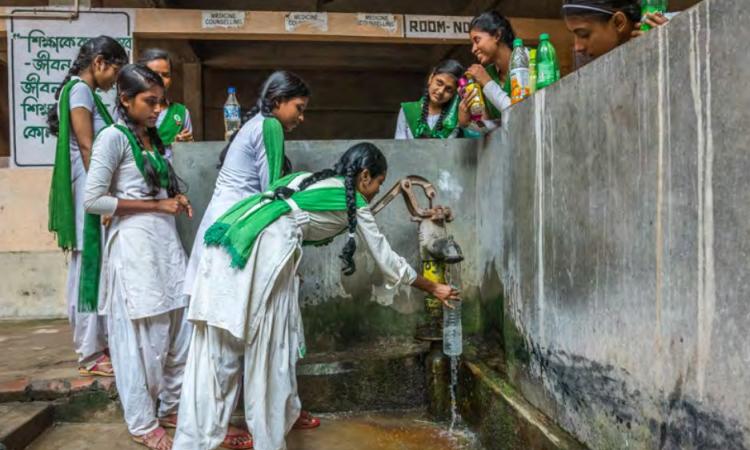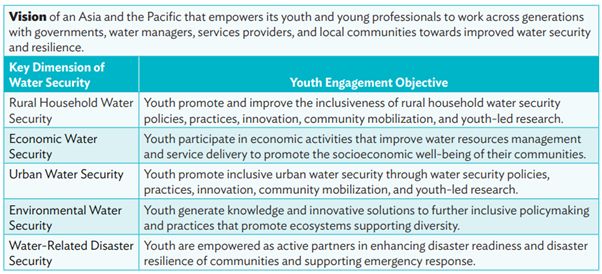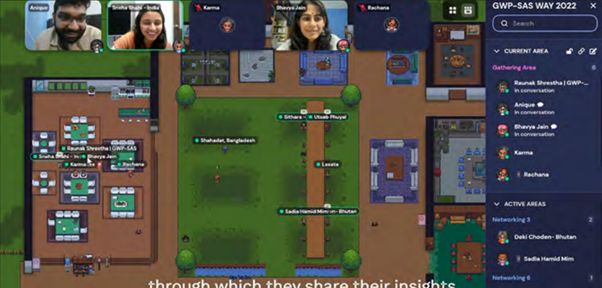
Empowering youth in Asia-Pacific's water sector is vital for sustainable water security. Engaging young professionals brings fresh perspectives, innovative solutions, and updated skills to address climate change, urbanisation, and water scarcity challenges. Youth also provide significant inroads to local networks and fresh perspectives to catalyse improved water and sanitation service provision and water resources management.
A recent report by Asian Development Bank ‘Engaging young people in Asia and the Pacific’s water and sanitation management’ advocates for meaningful youth involvement, offering models, case studies, and opportunities to enhance water sector policies and projects through youth participation.
One quarter of the region's population is under twenty-five years old. This report presents case studies to demonstrate the benefits of engaging young people in the design, delivery and evaluation of water supply and sanitation projects. In the face of increasingly complex water sector challenges, driven by factors such as climate change and rapid urbanisation, young people can provide new and innovative perspectives. The publication outlines practical ways in which development practitioners in the water sector can involve young people in their work.
Inclusion matters
Inclusion is critical for building a fair and just society that respects and values diversity. Inclusive practices ensure that not only youth but people of all ages have equal opportunities to participate in social, economic, and political life, regardless of race, ethnicity, gender, sexual orientation, religion, disability, or socioeconomic status. Furthermore, evidence shows that companies with diverse workforces and inclusive cultures are more likely to outperform their peers.
Water as a sector can benefit from increased youth participation. Globally, and particularly in Asia and the Pacific region, most water subsectors such as irrigation management, water supply, and sanitation, take traditional approaches in their planning and service delivery and generally lack an intergenerational workforce. Further, about one-third of the water sector workforce is eligible to retire in the next 10 years. Engaging youth can help develop young people to become leaders and change agents in the sector.
Young people lead on innovation and digitalisation
Youth engagement can help address the urgent need for innovation and digitalisation within the water sector. In this highly conservative sector, innovative solutions have been slowly adopted and recognised as viable alternatives to traditional modes of operation.
Although there is limited data for youth-led digitalisation efforts in the water sector, a report from the World Economic Forum points to the importance of intergenerational skills transfer, from the youth to the older generation, to address digital skills gaps in the Association of Southeast Asian Nations. Therefore, early contact with the water industry through internships or flagship projects can not only generate interest in the sector from students and young professionals and benefit water entities with competent and tech-savvy staff but can also help combat the generalised skills mismatch between qualified recent graduates and opportunities in the job market.
Table: Vision for meaningful youth engagement

Source: ADB
Meaningful youth engagement can be achieved through various models, including opportunities for young professionals, as highlighted by many of the case studies throughout this publication.
- Young professional opportunities. Long-term or intensive programs targeting government officers, university students, recent graduates, junior practitioners, and nongovernment organisation staff can build and sharpen knowledge and provide pathways to becoming water professionals. These can be especially useful to embed young staff in program management units and project implementation units. Terms of reference allowing the engagement of young professionals also create avenues for the career development of youth and the adoption of new trends in the water sector.
- Volunteer programs. Volunteering can be promoted among recent graduates from local universities to contribute to pressing sector issues, such as accelerating universal access to water supply and sanitation. Volunteers can receive training to become trainers to develop the capacity of community water and sanitation user groups and improve the administration, operation, and maintenance of local water and sanitation systems.
- Thematic workshops. Workshops or trainings can be held to explore the frontiers of science, technology, and practice and to foster discussion among interdisciplinary, cross-sector communities of practice. This approach can help provide opportunities for the creation and promotion of pragmatic and innovative solutions to challenges in urban and rural water, sanitation and hygiene, and basin-wide water management.
- Media fellowships. Youth fellowships in media can engage and strengthen relationships with local media outlets while providing capacity building and information to local journalists about water issues. These fellowships can be associated with high-level reporting of events associated with project activities.
- University participation. Projects can engage with engineering universities to seek students interested in joining the project preparatory technical assistance for their research theses.
- School events. School-based events can engage schoolchildren and teachers and raise awareness of water issues. Different ages can be targeted with activities of varying complexity.
Case study: Water Academy for Youth
In 2021, the Global Water Partnership (GWP) launched the Water Academy for Youth (WAY) program to promote leadership, capacity building, mentorship, fellowships, internships, networking, and intergenerational dialogue. WAY is an interactive and customisable program that can be adapted to the needs and context of the region or country where it is being implemented. The program aims to support the acceleration of the Sustainable Development Goals and improve the skills of young leaders. WAY has been implemented at a regional level in the Caribbean, South Asia, Southeast Asia, and Southern Africa.
Innovation, entrepreneurship, and thematic tracks have been developed. The entrepreneurship track focuses on creating bankable business ideas, while the thematic track focuses on project and proposal development. Each region was able to adapt its program subcomponents for each track by including areas of interest such as transboundary water cooperation, the water–food–energy nexus, integrated water resources management, storytelling, leadership, climate adaptation, problem solving, and proposal and concept note writing.
WAY is not a standalone program but a starting point to further engage youth in the water sector by fostering connections with facilitators, mentors, and the GWP network. Continued youth inclusion can take place through communities of practice, youth organisations, employment opportunities, country youth focal point placements, and seed funding for selected outputs. Mentors and facilitators play a key role in creating connections for youth with water community actors, and some mentor–mentee relationships have continued after program completion.
WAY participants have also been able to represent their countries or regions as youth cohosts in national, regional, and global dialogues, such as the 'Transformative Futures for Water Security Conference' in February 2023. Through WAY, participants developed research projects, stories, project concept notes, and proposals, which have the potential to be refined and extended as full projects.

Networked for change. An interactive session during the South Asia Water Academy of Youth (Image: Global Water Partnership South Asia)
Lessons from youth engagement programs
Several common themes and lessons from the case studies can inform the design and development of meaningful youth engagement programs.
- Work with rather than for youth. Program design must be informed by the needs identified by youth. Having youth (co)lead project components and putting youth needs at the program’s core allow for greater interest and commitment from youth participants.
- Highlight youth contributions. The participation of youth in high-level panels and intergenerational dialogues allows senior professionals to see value in youth contributions and provide perspectives that would otherwise not be considered. Investing in the visibility of youth participation promotes youth networks, highlights their role in decision-making, and encourages pathways for government institutions to support youth inclusion.
- Provide mentorship and intergenerational dialogue. Mentorship is key to the success of capacity-building programs, as mentors complement the curriculum with water-specific knowledge and provide guidance on career development. Interactive sessions and presentations allow seasoned professionals to engage with youth participants in intergenerational discourse.
- Sustain youth engagement. Youth capacity building should not be a one-off engagement; it must include opportunities and pathways for further engagement. This requires fostering a collaborative, open environment where the youth can organise themselves and collaborate for future action. These forums should foster and welcome new ideas and facilitate pathways that support youth in achieving their goals and ambitions.
- Foster commitment and accountability. Strong commitment from partners, local governments, and the youth enables successful youth initiatives. Concrete and actionable commitments lead to improved results. In building commitment, it is necessary to communicate expectations, establish systems for collaboration, and define accountabilities.
- Embed capacity building in youth projects. Training sessions about budget management and reporting enable youth organisations to improve managerial and operational tasks. Pairing youth projects with skills-building initiatives can also help familiarise youth with project reporting procedures that can improve their professionalism and employability and allow them to access funds for further action.
- Encourage local ownership. Local communities and individuals need to be empowered to take ownership of water challenges and solutions. By involving community practitioners, innovators, and entrepreneurs in the process, youth programs can generate solutions tailored to the needs and capabilities of the local communities. This approach not only leads to customised and sustainable solutions but also fosters a sense of ownership and responsibility among community members, including youth.
The full report can be accessed here
/articles/fostering-youth-engagement-water-management